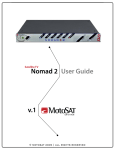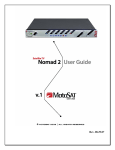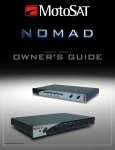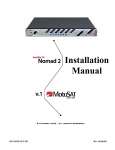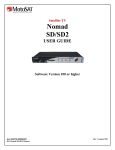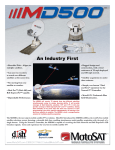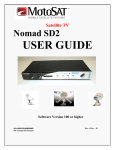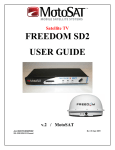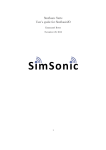Download MotoSAT AutoMotion Dome T2 Specifications
Transcript
NOMAD UNIVERSAL CONTROLLER USER INSTRUCTIONS MANUAL The NOMAD Universal Controller gives all new meaning to the word simplicity with its easy one step process this revolutionary product will bring satellite TV technology to new heights. Table of Contents: NOMAD Bill of Materials (Packaged Components).…………….. 2 NOMAD Specifications….……………………………………….. 2 Using the NOMAD Universal Controller First Time Installation……………………………….. 3, 4 Test Dish Functions…………………………………. 3, 4 Explanation Display Options Front Panel…………………………………………… 4 Button Operations (Find Satellite/Stowing the Dish)... 4 Dish Services and Their Assigned Satellites………… 4, 5 Front Panel LEDS……………………………………. 5 Explanation NOMAD Hardware Rear Panel……………………………………………. 5 Control Cable Wiring Diagram……………………… 7 Dip Switch Guide (Dish Services)…………………... 8 Dip Switch Guide (Switch Options/Configurations)… 9 (Show Mode Switch)……………. 9 Trouble Shooting and Error Codes……………………………..… 10 Technical Support Info…………………………….……………….. 12 Products Used with the NOMAD………………………………….. 12 Important Notes for Dish Network...……………………………..… 13 Rain Fade Effect on Domes………………………………………… 14 Dual Receiver Diagram for Dish Network MD500…………………. 15 1 NOMAD Universal Controller Bill of Materials: The NOMAD Universal Controller Systems (when shipped with a mount of choice) are shipped with the following components: Components shipped with NOMAD Controller: - NOMAD Universal Controller - 12 VDC 4 AMP Power Supply - NOMAD Universal Controller User Manual Components shipped with your mount of choice: - 30’ Control Cable - 30’ Coax Cable NOMAD Universal Controller Specifications: - 10 7/8” Wide by 9 ¾” Deep by 1 1/16” Height Voltage Requirements: 12VDC 4 AMP power supply (supplied) 2 Using the NOMAD Universal Controller ● Dish Pro 500 (300,500,800) Series Receiver(s) are a required component when using the Model MD500. First Time Installation: 1- Plug in all necessary cable connections to the back of the NOMAD (see pg 6). Note: Plugging the receiver and NOMAD controller into an independent power strip is recommended. 2- Connect coax from NOMAD to Mount. (Labeled “To Nomad) 3- Set the dip switches to match your specific mount model whether it is a Skewable or Non-Skewable (see pg. 8-9 for specific settings.) 4- To run the “MANDATORY” Test Dish function, set dip switch #1 to the ON or UP position, (Note: For non-skewable single LNB dishes, 1 and 3 must be “ON”) then turn the Power Switch to the ON position on the NOMAD controller. There will be an approximate 15 second delay and the Stow LED will begin to flash, indicating that the dish is moving. At the completion of the Test, the Stow LED will go steady. The total Test Time is up to 3 minutes. During the test cycle the Nomad will run the mount to all extremes and then return it to the stowed position. “CAUTION” – TEST DISH ON A NONSKEWABLE MOUNT MUST HAVE SWITCH # 3 IN THE ON POSITION. 3 The purpose of the “MANDATORY” test dish: A- Automatically determines if the non-skewable mount is a Dome or Open Face dish. (See pg 8, 9 for “specific” dish switch settings) B- Checks to ensure proper working order of all (Elevation, Azimuth, Skew) motor functions. 5- Upon successful completion of the Test Dish function, turn “OFF” the Power Switch and set the dip switches to identify your specific mount (skewable or nonskewable) and satellite service settings such as, Dish Network, Dish 500 (2 LNB), DirecTV, Direct HDTV (3 LNB), Bell ExpressVu (2 LNB) or Star Choice. (See pg. 8, 9 Dish Services: Options & Configurations.) 6- After properly setting the dip switches for your application, turn “ON” the Power Switch on the rear panel of the NOMAD Universal Controller. Start up will take approximately 5 seconds. Note: When the Power Switch is turned “ON” the PWR (power), LNB and STOW LEDS will be lit. NOMAD UNIVERSAL CONTROLLER “FRONT” PANEL BUTTONS: FIND: (Find Satellite) Pressing the Find button will begin the dish “search” to locate and lock onto the “main” satellite. For non-skewable single LNB dishes pressing the Find button, while on satellite enables you to switch between multiple satellites. For example: (Pressing the find button while locked onto • Dish Network will toggle between satellites 119 and 110. • DirecTV will toggle between satellites 101, 110 and 119. • Bell ExpressVu will toggle between satellites 91 and 82. • Star Choice will toggle between satellites 107 and 111.* *Coming soon 4 Dish Services and their Assigned Satellites 1. 2. 3. 4. Dish Network – Can use satellite(s) 119 & 110 DirecTV – Can use satellite(s) 101, 110 & 119 Bell ExpressVu – Can use satellite(s) 91 & 82 Star Choice – Can use satellite(s) 107 & 111 REPEAK – Skewable Mounts ONLY - Pressing the Find button, when “on satellite” and the signal strength shows weakness, will re-peak the dish for a higher signal quality when using the twin LNB skewable dish model(s) MD500 or triple LNB MDHDTV ONLY. (Note: Single LNB non-skewable dishes “re-peak” during satellite transition.) STOW: (Stowing the Dish) Pressing this button returns the dish to its stowed or travel position. LED’S: LNB: When lit, this LED indicates the coax cable from the receiver has been correctly connected to the NOMAD Universal Controller, and the receiver has power. (Note: The LNB LED is illuminated once the coax cable of the receiver has been connected, but does NOT indicate the Controller has power). LOCK: When lit, this LED indicates the “strongest” or “highest” signal strength of the satellite has been achieved. PWR: When lit, this LED indicates the NOMAD Universal Controller power has been turned on. PEAK: When lit, this LED indicates the dish has found a signal and is adjusting for the “strongest” or “highest” signal strength of the satellite. FIND: When the “Find” button has been pressed, the Find LED will blink until a satellite has been identified and can establish a connection. Once the satellite has been identified, the Find LED will remain solid. (The Stow LED also blinks indicating motor movement.) If the Nomad is locked on the satellite, pressing the “Find” button again will activate a re-peak routine which will verify the dish alignment to the satellite for optimum signal level for skewable dishes (MD500 and MHDTV). Pressing the Find button on non-skewable dishes (Dome and Executive) allows you to switch between satellites. STOW: When the “Stow” button has been pressed, the Stow LED will blink indicating motor movement as the dish is being stowed. Once the dish has been stowed, the Stow LED will remain solid. 5 NOMAD UNIVERSAL CONTROLLER “REAR” PANEL On/Off Switch Power Connector Control Connector Dip Switch From Dish To Satellite Receiver Satellite IN Serial Port Power Switch: Depressed, the “1” indicates the controller is in the “ON” position. Depressed, the “0” indicates the controller is in the “OFF” position. Power Supply Interface: Is used to connect the 12 VDC 4 AMP power supply to provide power to the NOMAD Universal Controller. (Note: Only use the power supply provided by MotoSAT or a power source known to have at least a 4 Amp min.) P1 P2 P3 +12V -GND Unused 6 Control Cable Interface: Connects the mount by way of a 9 pin conductor cable to the NOMAD Universal Controller. The cable is color coordinated for exact connection configuration. (See Figure Below) Wiring to 9 Pin Control Connector Black-Brown-Red-Orange-Yellow-Green-Blue-White-Purple (Purple is only used on Skewable Mounts, and not required on Non-Skewable Mounts) Serial Port: Used to provide software upgrades. From Dish: Coax connection from the dish to the NOMAD Universal Controller. To Satellite “IN” on Receiver: Coax connection used to connect the NOMAD Universal Controller to the satellite/LNB connection on the satellite receiver. Dip Switches: Will provide precise configuration of the NOMAD Universal Controller to specific satellite TV configurations. “Caution” - Power must be turned off before changing Dip Switch settings! Dip Switches 7 Dish Services: Options & Configuration 8 Dipswitch Operation: Options & Configuration 9 TROUBLESHOOTING “CAUTION” – The dish needs to be STOWED and the Power Switch has to be in the OFF position before switching any of the dip switches. LED ERROR CODES - Probable Cause and/or Resolution: NOMAD Universal Controller Error Code Matrix LED Lights Flashing Power X X X X X X X X X Peak Lock Find X X X X X X X X X X X X Cause of Error Stow X Invalid Dip Switch. Skewable vs Non-Skewable mount Invalid Network ID Motor time out. No counts with Azimuth motor. Limit error - Elevation movement Limit error - Skew movement No DVB power but DVB connected Main satellite not found but secondary satellite found / ALSO NO SATELLITES FOUND Signal lost, or no LNB power Over temperature on NOMAD (NOMAD too hot. Cool it down) 10 X X X X X X X X X X X X X X X X X X X X X X X X X X X X X X X X Coax cables reversed on NOMAD Satellite signal too strong Could not find main satellite after skewing dish Invalid Dip Switch, Improper identification of Dome or Skewable mount Motor Time Out. No counts on Elevation motor. Motor Time Out. No counts on Skew motor. Limit Error - Azimuth movement No Receiver (or LNB) power Only main satellite found Signal lost but LNB power present Azimuth, Elevation or Skew motor active (This is not an error but a Motor is active) Dish did not raise minimum height DVB Board has failed Not enough satellite signal Lost Code - Call Customer Service for Upload Module (SOLID LED, NOT FLASHING) NOTE: Before calling Technical Support please perform a “Test Dish” and press “Find” one more time before calling. Technical Support - MotoSAT Customer/Technical Service – (1-800-247-7486) - Available MonFri 9:00 a.m. to 5:00 p.m. Mountain Standard Time. ● Please have your MotoSAT Model # and Satellite Receiver Brand prior to calling Customer/Technical Support. 11 12 Special Notes Stowing the dish when all else fails. If you are able to go onto the roof 1. Unplug the “Green” 9 pin connector from the back of the NOMAD. 2. Go to the roof where you can apply a slight amount of force to move the dish into an acceptable position for traveling. 3. Call Tech Support when you get to a location that you can perform trouble shooting. If you are unable to go onto the roof – The dish can be manipulated by applying 12 volt DC power to specific wires in the control cable located in the back of the NOMAD. The 12 Volts going to your NOMAD controller (3 pin “green” connector) can be used as this source. 1. ELEVATION - Orange and Red wires (reversing polarity will change direction.) 2. AZIMUTH - Black and Brown (reversing polarity will change direction.) If a chain or motor/gearbox assembly is broken, the dish will have to be stowed by hand. Dish Network receivers NON-SKEWABLE Dome or Open Faced mounts. If your satellite receiver is a Dish 500 or Dish Pro and you remove it from your home to your RV, you will need to perform a “Check Switch” while the non-skewable dish is in the STOWED POSITION. Your screen upon completion of the “Check Switch” should have 8 X’s in the check boxes meaning that the “Check Switch” failed. This procedure must be accomplished before you “FIND” satellite. Failure to do so will result in improper operation of the receiver. 13 RAIN FAID ON DOME SYSTEMS Read all about it…………. Subject: Rain fade on Domed (Covered) Systems What is rain fade? Rain fade is signal degradation due to the interference of rain droplets. Rain can affect performance as well as heavy water content thunder clouds. Satellite frequencies have a great deal to do with degradation. C band satellite frequencies have the best resistance to rain fade, KU band satellite frequencies have the next best performance, and KA band frequencies are the most susceptible to rain fade. Rain fade is also known as rain attenuation. There are quiet a few examples of rain fade or degradation. 1. There is heavy rain (large droplets); it can block the uplink channels for reception. 2. There is heavy rain that can block the receive signal to the satellite. 3. There is also moisture build-up on the dome or cover. Unfortunately, all these examples are caused by acts of nature, that with a domed system you will always experience all of the symptoms in varying degrees. There are things you can do to reduce degradation. 1. If you live in Seattle, move to Arizona. 2. Get a big fan, point it towards the sky and blow the clouds away. 3. KEEP YOUR DOME CLEAN- Soap and water are the most efficient methods. Some harsh or abrasive cleaners can be harmful to the outside of the dome as well as signal interference. NOTE: Some types of cleaners as well can eventually collect dirt. Be sure to select one that will work for you. 4. After rain, wipe the water droplets off the Dome. 5. A bigger dish size and superior surface accuracy reduces rain fade problems. All domes on the market are susceptible to rain fade. MotoSAT’s Dome (aka Mini Dome) as well as the T2 AutoMotion are the two domed satellite television systems that have the lowest rain degradation on the market. Because of size and surface accuracy of our dish, MotoSAT can offer the best performance in rain fade situations. Your Staff at MotoSAT 14 WHITE::PAPER 4.11.05 DUAL RECEIVER DIAGRAM FOR THE MD500 This diagram shows a setup of equipment for using a MD500 with dual receivers or a PVR receiver. 110° From Dish 119° Dish Network Dish Pro DP34 Multiswitch Sat 1 Nomad Controller Sat 2 To VHF Antenna In Two DishPro Receviers DishPro PVR OR Please call MotoSAT for information on this or any other technical subject contact MotoSAT at: 1-800-247-7486
















